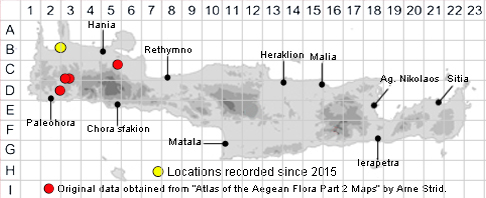
ARUM CYRENAICUM
Family:- ARACEAE
Common Name:- None
Synonyms:- None
Meaning:- Arum (Gr) A name used by the Greek philosopher Theophrastus.
Cyrenaicum (L) From Cyrenaica in north-eastern Libya.
General description:- Tuberous herb sprouting in early autumn.
Tubers:-
a) 3.5-5 cm across, 2-2.5 cm thick.
b) vertical.
Leaves:-
1) Lamina:
a) 8.5-20 cm long, 4-12 cm wide.
b) broadly sagittate, apex obtuse to rather bluntly acute.
c) deep green, semi-glossy.
2) Petiole:
a) 5.5-27 cm long, 3-6 mm wide.
b) circular in cross section (terete).
c) dark green with moderate purple staining.
Flower:-
a) smelling slightly of horse-dung.
1) Peduncle:
a) 3-11 cm long, 5-7 mm wide.
b) not exceeding the leaves.
c) terete.
d) longitudinally striped with lighter green and moderately stained with purple.
semi-glossy mid-green.
2) Spathe:
a) 10.5-16 cm long.
3) Spathe-tube:
a) 2.5-4 cm long, 2-2.5 cm wide.
b) oblong-cylindric, constricted apically.
c) exterior pale green with a narrow dull purple margin, interior dark purple, fading
to pale green basally and deepening to plum-purple apically.
4) Spathe-limb:
a) 8.5-12 cm long, 4-5.5 cm wide.
b) elliptic, erect, the apex drooping forwards as the inflorescence ages, narrowing
gradually to a point (acuminate).
c) externally greenish, flushed with purple towards the edges, interior pale rosy
purple to dark purple, fading to pale purple towards the tube and apex, limb
green at the tip.
5) Spadix:
a) c. ½ as long as the spathe-limb, 7-9.5 cm in total length.
b) appendix slender-club-shaped (clavate), long-stipitate, 3.5-6.5 cm long,
5-7 mm wide.
c) deep purple with a slight olive-green tinge, stipe darker.
Fruit:-
1) Berries:
a) 4-9 x 3-5 mm.
b) pyriform.
Key features:-
1) Spathe-limb interior purple, fading to pale green basally.
2) Spadix-appendix slender-cylindric, long-stipitate.
Habitat:- Grows in riparian woodland (interface between land and a river) and
among rocks and boulders below 750 m.
Distribution:- Endemic W. Crete & NE. Libya. Cyrenaica in north-eastern Libya.
On Crete only in the south-west, Kakodikianos valley north of Paleohora as far as
Kandanos. Rare.
Comments:-
Recorded from Crete for the first time in 1992, and is as yet known only from the
south-west, in the eparhia of Selinos, Previously, it was a rather enigmatic species
known only from Cyrenaica in north-eastern Libya.
Flowering time:- Mar- Apr.
Photos by:- Fotis Samaritakis
Status:-
Listed in "The Red Data Book of Rare and Threatened Plants of Greece" as "VU"
vulerable.
SPECIES DESCRIPTION
